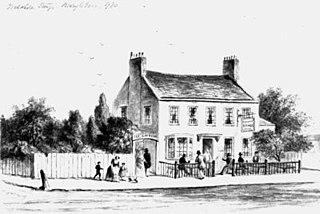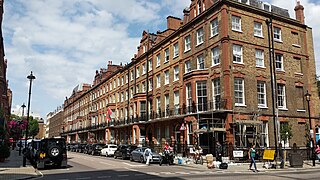
The Metropolitan Borough of St Marylebone was a metropolitan borough of the County of London from 1900 to 1965. It was based directly on the previously existing civil parish of St Marylebone, which was incorporated into the Metropolitan Board of Works area in 1855, retaining a parish vestry, and then became part of the County of London in 1889.

St James's is a central district in the City of Westminster, London, forming part of the West End. In the 17th century the area developed as a residential location for the British aristocracy, and around the 19th century was the focus of the development of gentlemen's clubs. Once part of the parish of St Martin in the Fields, much of it formed the parish of St James from 1685 to 1922. Since the Second World War the area has transitioned from residential to commercial use.

The Portman Estate, covering 110 acres of Marylebone in London’s West End, was founded in 1532 when the land was first leased to Sir William Portman.
Lisson Grove is a street and district in Marylebone, City of Westminster, London. The neighbourhood contains a few important cultural landmarks, including Lisson Gallery, Alfies Antique Market, Red Bus Recording Studios, the former Christ Church, now the Greenhouse Centre, and the Seashell of Lisson Grove.

The Yorkshire Stingo was a public house in Marylebone in the 18th to mid-20th century. Its name came about because it was customary for Yorkshiremen in London to gather at the pub and its adjoining pleasure gardens on the first three days of May each year. In May 1808 it was reported that over 20,000 people gathered there, drinking strong ale, playing football and other 'rustic Yorkshire sports'. The Stingo part of its name comes from a fashionable slang word of the 18th century for strong or old ale. The term is possibly derived from the sharp, or "stinging" flavour of a well-matured beer.

Marylebone is a district in the West End of London, in the City of Westminster. Oxford Street, Europe's busiest shopping street, forms its southern boundary.

In British usage, the term townhouse originally referred to the town or city residence, in practice normally in Westminster, near the seat of the monarch, of a member of the nobility or gentry, as opposed to their country seat, generally known as a country house or, colloquially, for the larger ones, stately home. The grandest of the London townhouses were stand-alone buildings, but many were terraced buildings.

Nottingham Place is a street in the City of Westminster that runs from Marylebone Road in the north to Paddington Street in the south. The street was named after the Harley family estates in Nottinghamshire. Former residents include the social reformer Octavia Hill, who also had a school there, stained glass artist Charles Eamer Kempe, the London Bible College,and The Kashmir Klub. Current residents include the High Commission of the Maldives and the Latvian embassy.

Crawford Street is a street in the Marylebone district of the City of Westminster, London. The street contains two grade II listed public houses.

Homer Row is a street in the Marylebone district of the City of Westminster, London, that runs form Old Marylebone Road in the north to the junction of Crawford Place and Crawford Street in the south.

Crawford Place is a street in the Marylebone district of the City of Westminster, London. The street was developed in the first decade of the 1800s and was original known as John Street West.

Henrietta Place, originally known as Henrietta Street, is a street in Marylebone in the City of Westminster in central London that runs from Marylebone Lane in the east to Cavendish Square in the west. It is joined on the north side by Welbeck Street and Wimpole Street, and on the south side by Vere Street, Chapel Place, and Old Cavendish Street.
This is a list of the etymology of street names in the London district of Mayfair, in the City of Westminster. It utilises the generally accepted boundaries of Mayfair viz. Marble Arch/Cumberland Gate and Oxford Street to the north, Regent Street to the east, Piccadilly to the south and Park Lane to the west.
This is a list of the etymology of street names in the London district of Marylebone. The following utilises the generally accepted boundaries of Marylebone viz. Marylebone Road to the north, Great Portland Street to the east, Marble Arch and Oxford Street to the south and Edgware Road to the west.
Lisson Green is described as a hamlet in the Domesday book in 1086, the edges of the settlement defined by the two current Edgware Road stations facing onto Edgware Road or Watling Street as it was previously known, one of the main Roman thoroughfares in and out of London. Occasionally referred to as Lissom Grove, originally Lisson Grove was part of the medieval manor of Lilestone which stretched as far as Hampstead. Lisson Green as a manor broke away c. 1236 with its own manor house. Paddington Green formed part of the original Lilestone estate.

Gloucester Place is a street in Marylebone in Central London. Located in the City of Westminster, it runs north from Portman Square across the Marylebone Road eventually merging into Park Road. It is parallel to Baker Street to the east and forms part of the A41 road from nearby Marble Arch.

Seymour Place is a street in Marylebone in Central London. Located in the City of Westminster, it runs north from Seymour Street until it meets Marylebone Road, where it becomes Lisson Grove. It is crossed by Crawford Street, George Street, and York Street and runs parallel to Gloucester Place, which lies to its east. Its southern end is about 180 metres northwest of Marble Arch and about 40 metres east of Edgware Road.

York Street is a street in Marylebone in Central London. Located in the City of Westminster, it runs west from Baker Street in a straight line until it begins curving when it becomes Harcourt Street towards the Old Marylebone Road. It crosses a number of streets including Seymour Place, Upper Montagu Street and Gloucester Place.

George Street is a street in Marylebone in Central London. Located in the City of Westminster, it runs east from Edgeware Road until it reaches Marylebone High Street at its junction with Thayer Street. It crosses a number of streets including Seymour Place, Gloucester Place, Manchester Street and Baker Street.

Chiltern Street is a road in the Marylebone area of Central London. Located in the City of Westminster, it runs north to south connecting Marylebone Road and Blandford Street. Baker Street runs parallel a little way to the west. It meets Dorset Street, Crawford Street and Paddington Street along its route. Manchester Square is located beyond the southern end of the street.


















